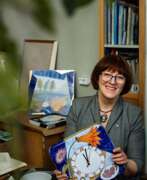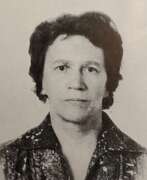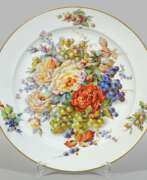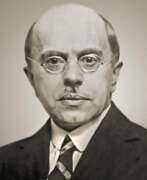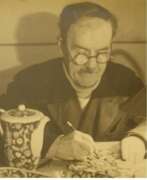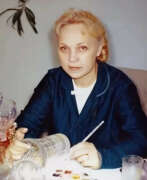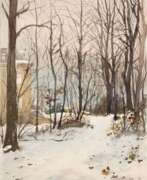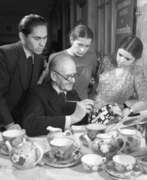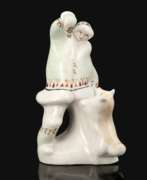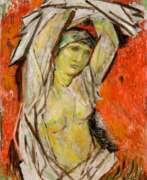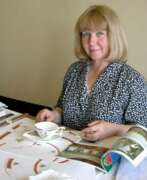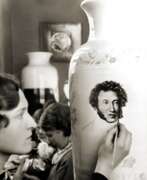Porcelain painters 20th century


Albert Samuel Anker was a Swiss painter, gesture painter and graphic artist.
Albert studied at the École Nationale Supérieure des Beaux-Arts in Paris and exhibited his work at the Paris Salons, where he was awarded a gold medal in 1866. Anker painted many realistic portraits and genre scenes of ordinary Swiss life. In many of them he depicted children, including his own. Thanks to his paintings, Albert Anker was the most popular genre painter of 19th century Switzerland. He also decorated more than 500 earthenware plates for the Alsatian ceramicist Theodor Deck.
Anker was a member of the Grand Council of the Canton of Bern, initiated the creation of the city museum, and held the rank of officer of the Legion of Honor.


Charles Garabed Atamian is a French artist of Armenian origin born in Turkey.
He studied for a time at the Academy of Fine Arts in Venice, then worked as chief designer at a porcelain factory in Istanbul. In 1894, Atamian worked with a team of artists to decorate the new palace of Sultan Abdul-Hamid Il in Yildiz, on the European side of the Bosphorus. He designed, among other things, the patterns for the ceramic tiles of the palace walls.
In 1897, Atamian emigrated to France and began illustrating books and magazines, as well as working on sets for several Parisian theaters. Since 1903 Atamian participated in various exhibitions with unquestionable success. He painted landscapes, sea and beach scenes with children (including some 200 paintings at Saint-Gilles in the Vendée, where he resided each year during the summer months from 1923 to 1939). Throughout his career he was a fine portrait painter. He became a member of the National Society of Artists in 1927.


Joseph Birbeck I was a renowned English ceramic painter born in 1862. He was known for his exquisite work on bone china and porcelain, especially with designs that feature intricate fish, game birds, and landscapes. Birbeck's career highlights include his contributions to Royal Doulton and other renowned potteries in Staffordshire, England.
His artistry is well-regarded, with various hand-painted works sold at auction and featured in private collections. Some of his notable pieces include Royal Doulton bone china fish plates made for Tiffany & Co., New York, often hand-painted with intricate fish designs and signed "J. Birbeck, Sen."
Several works by Birbeck are highly valued by collectors and are found in prestigious auction houses and antiques marketplaces. If you're interested in collecting his works or learning more about them, you can find a range of his pieces, such as ornithological cabinet plates and decorative vases, at various auctions and antique dealers.
For those interested in exploring the art and history of Joseph Birbeck I, there are numerous platforms where you can track his pieces and find upcoming sales. Consider signing up for updates on upcoming sales and auction events focused on Birbeck's art. This subscription will keep you informed about new product releases, exclusive collectible items, and related news in the field of art and antiques.


Louis-Alexandre Cabié was a French landscape painter.
He was inspired by charming views of the French provinces. He painted many landscapes of the Charente near Cognac, the banks of the Gironde, Royan, and the cliffs of Saint-Georges-de-Didon, as well as on the banks of the Weser. Cabié also painted his landscapes on vases at the Vieillard ceramics factory in Bordeaux.


Ilya Grigorevich Chashnik (Russian: Илья Григорьевич Чашник) was a Russian Suprematist artist, known for his close association with Kazimir Malevich and as a pioneering member of the UNOVIS school. Born in 1902 in Lucyn, Russian Empire (now Ludza, Latvia), Chashnik's artistic journey began in Vitebsk, where he was deeply influenced by the avant-garde movements of the early 20th century. He studied at the Vitebsk Artistic-Practical Institute under Malevich and became one of his most faithful disciples, embracing Suprematism's focus on basic geometric forms and the use of a limited color palette.
Chashnik's work is characterized by his exploration of Suprematist principles across various forms of art, including painting, metalwork, and ceramics. His art is distinguished by a dynamic use of forms, often incorporating complex tonal relationships and achieving a sense of rhythm and symmetry. Notably, Chashnik applied these principles to the design of everyday objects, making significant contributions to porcelain design at the Lomonosov Porcelain Factory. His designs for the factory revealed his inventive approach, combining Suprematist aesthetics with practical applications.
Despite his untimely death in 1929 at the age of 27, Chashnik's legacy in the art world remains profound. His works are held in several prestigious collections, including the Thyssen-Bornemisza Museum in Madrid and the Museum of Modern Art (MoMA) in New York. These institutions recognize Chashnik not just for his artistic output but also for his significant role in the development of Suprematism and its application beyond traditional canvases.
For those interested in the intersection of avant-garde art and practical design, Ilya Chashnik's work offers a fascinating study. His ability to translate the visionary ideas of Suprematism into tangible objects marks him as a key figure in the movement's history. To stay updated on new insights and sales related to Ilya Grigorevich Chashnik's work, sign up for updates and don't miss out on the opportunity to explore the works of this groundbreaking artist.




Arshile Gorky was an Armenian-American painter who had a seminal influence on Abstract Expressionism. He spent the last years of his life as a national of the United States. Along with Mark Rothko, Jackson Pollock and Willem de Kooning, Gorky has been hailed as one of the most powerful American painters of the 20th century. The suffering and loss he experienced in the Armenian genocide had crucial influence at Gorky’s development as an artist.


Elena Graure-Manta is a Romanian glass and porcelain artist based in Germany.
Elena studied under the glass and porcelain artist Clausenburg (Romania), at the Romanian Academy of Fine Arts, and worked as a designer for the Avrig glass manufactory. In her work, she takes objects from everyday life as a basis and, endowing them with her imagination, creates glass works of art from them. In this way Elena Graure-Manta created a series of glass shoes and handbags, and later glass "luxury cars". Graure-Manta's glass objects are very colorful and contain many details, making each piece unique and interesting.
From 1995-2005, the artist owned the Vitrumex glass manufactory in Romania and works in her own studio in Erftstadt, Germany, near Cologne.


Reinhard Minkewitz is a German graphic artist and draftsman.
He graduated from the Academy of Fine Arts in Leipzig, lives and works in this city.
The figurative artist Minkewitz works on large format paintings, in addition he creates sculptures, ceramics, art prints and also collaborates with the Meissen porcelain manufactory.




